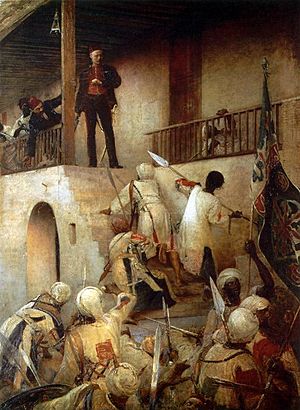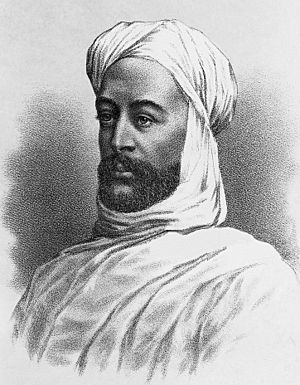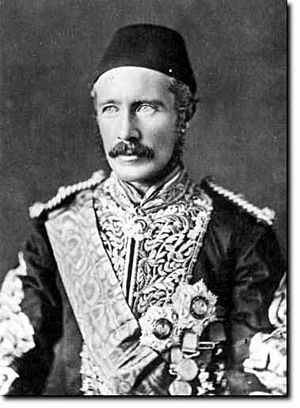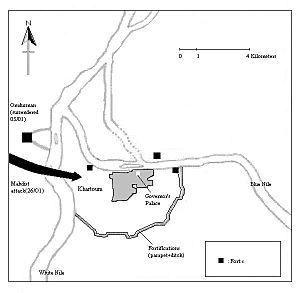Siege of Khartoum facts for kids
Quick facts for kids Siege of Khartoum |
|||||||
|---|---|---|---|---|---|---|---|
| Part of the Mahdist War | |||||||
 Portrayal of Gordon's death by George W. Joy |
|||||||
|
|||||||
| Belligerents | |||||||
• Egyptian Sudan |
|||||||
| Commanders and leaders | |||||||
| Strength | |||||||
| 7,000 troops 9 gunboats |
30,000 to 50,000 troops | ||||||
| Casualties and losses | |||||||
| Entire force destroyed | unknown, but reportedly heavy | ||||||
| ~4,000 civilians dead, many others enslaved | |||||||
The Siege of Khartoum was a long and important battle. It happened from March 13, 1884, to January 26, 1885. During this time, a group called the Sudanese Mahdists took control of the city of Khartoum. They captured it from the Egyptian soldiers who were protecting it. This victory gave the Mahdists control over all of Sudan.
Egypt had ruled Sudan since 1820. But by 1882, Britain had taken control of Egypt. In 1881, the Mahdist War started in Sudan. It was led by Muhammad Ahmad, who said he was the Mahdi, a special leader in Islam. The Egyptian Army could not stop this revolt. They lost several battles and had to retreat to their forts.
The British did not want to send their own soldiers to Sudan. Instead, they sent Charles George Gordon to be the Governor-General of Sudan. His orders were to get everyone out of Khartoum and other forts. Gordon arrived in Khartoum in February 1884. He found it impossible to reach the other forts, as they were already surrounded.
Instead of leaving right away, Gordon started to make Khartoum stronger. The city was soon cut off when local tribes joined the Mahdi. About 7,000 Egyptian soldiers and 27,000 civilians were trapped in Khartoum. They were surrounded by 30,000 Mahdist fighters. This number grew to 50,000 by the end of the siege.
The defenders tried to break out of the city, but they failed. Food supplies started to run out. They were supposed to last six months, but the siege lasted ten months. The soldiers and people in the city began to starve. After many months, the British government finally agreed to send help. As the rescue team got closer, the Mahdists attacked Khartoum at night. They broke through the defenses and killed all the soldiers, including Gordon. About 4,000 men living in the city were also killed. Many women and children were taken captive. The rescue team arrived two days later. They realized they were too late and left Sudan. The Mahdi then created a religious state in Sudan called the Mahdiyah. It lasted for fourteen years.
Contents
Why the Siege Happened
Sudan's Situation Before the War
The Khedivate of Egypt was like a smaller state under the Ottoman Empire. But after a war in 1882, Britain took control of Egypt. This made Egypt a British protectorate, meaning Britain had a lot of power over it. Britain mostly let Egypt rule itself, including its control of Sudan. The British saw Sudan as Egypt's own problem.
A rebellion began in Sudan in 1881. It was led by Muhammad Ahmad. He said he was the mahdi, a special leader who would save Islam. Many people in Sudan supported this Mahdist revolt. They did it for religious reasons and because they wanted to be free from Egypt.
The Egyptian Army tried to stop the revolt. But they were defeated by the Mahdists in November 1883. This happened at the Battle of El Obeid. The Mahdi's forces took the Egyptians' weapons and took over large parts of Sudan. But Egypt still had several strong forts in Sudan, like the one in Khartoum.
General Gordon's Role
The Egyptian defeat at El Obeid made the British government and public notice the Mahdi Revolt. The British Prime Minister, William Ewart Gladstone, did not want British soldiers to get involved in Sudan. He was worried that fighting would cost too much. This might stop Egypt from paying back its large debts to Britain.
So, the British told the Egyptian government to get all their soldiers out of Sudan. They wanted to leave Sudan to the Mahdists. A British soldier, Major-General Charles George Gordon, was put in charge. He had been Governor-General of Sudan before. His new orders were to lead the evacuation.
Gordon had different ideas about Sudan than Gladstone. Gordon believed the Mahdi's rebellion had to be stopped. He thought it would not end with just Sudan. He felt it might try to conquer Egypt and other areas. Gordon also worried about the weak Egyptian army. He wanted a stronger plan in Sudan.
Even with his own ideas, Gordon agreed to evacuate Sudan. He was given money and promised help from British and Egyptian leaders. On his way to Khartoum, Gordon stopped in Berber, Sudan. He told tribal chiefs there that Egypt planned to leave Sudan. This was a big mistake. The tribes became worried, and their loyalty to Egypt weakened.
Gordon Prepares Khartoum
Gordon arrived in Khartoum on February 18, 1884. The city was safe, with 7,000 Egyptian soldiers and 27,000 civilians. But three smaller forts nearby were already surrounded by Mahdists. Instead of leaving Khartoum right away, Gordon decided to try and rescue the other forts. He also started to manage Sudan.
He changed some rules the Egyptians had made. He stopped unfair arrests and torture. He also lowered taxes. To get people's support, Gordon made slavery in Sudan legal again. He had tried to stop it before, but this decision was popular in Khartoum. However, it caused problems in Britain.
Gordon then tried to get more soldiers for Khartoum's defenses. He asked for Turkish soldiers, but was refused. He then asked Britain for Indian troops, and later for 200 British soldiers. The British government said no to all his requests. They still wanted to avoid sending troops to Sudan.
Gordon became frustrated with the government's plan. His messages to the British office in Cairo became angry. He said he felt he had to rescue the forts and protect the people in Khartoum. It is not clear if he was trying to delay leaving or avoid it completely. On April 8, he wrote that leaving the forts would be "the climax of meanness."
The Siege and Battle
Khartoum is Surrounded
Knowing the Mahdists were getting closer, Gordon ordered stronger defenses around Khartoum. The city was protected by the Blue Nile to the north and the White Nile to the west. To defend the riverbanks, he turned nine small steamboats into gunboats. He added guns and metal plates for armor. In the southern part of the city, facing the desert, he built trenches. He also set up simple land mines and wire fences. The area around the city was controlled by the Shagia tribe, who were thought to be against the Mahdi.
On March 16, Gordon sent 200 Egyptian soldiers out of Khartoum. This attack failed, and all 200 soldiers died. By early April 1884, tribes north of Khartoum had joined the Mahdi. This included the tribes Gordon had met earlier. These tribes stopped river traffic on the Nile and cut the telegraph wires to Cairo. This meant the Siege of Khartoum had truly begun. The city could only rely on its own food, which was expected to last five or six months. By this time, over 30,000 Mahdist fighters surrounded Khartoum and the other forts.
From April onwards, Khartoum was cut off. Gordon had no money to pay soldiers or buy food. So, he printed special promissory notes, which were like IOUs. Messages to Cairo were sent by couriers, which took several days. Gordon also tried to talk to the Mahdi, but the Mahdi refused to let them leave peacefully. As the siege continued, food ran low. Starvation began for both the soldiers and the people in the city.
In September, the trapped soldiers in Khartoum tried to reach the fort at Sennar. They got out of the city but were defeated by the Mahdists. About 800 soldiers were lost. Another attempt to send a steamboat to Cairo also failed. All the people on board were killed, including Colonel Stewart, Gordon's assistant. Stewart had letters from Gordon that showed how bad things were in Khartoum. By the end of September, the Mahdi moved most of his army to Khartoum. This more than doubled the number of fighters around the city. By September 10, 1884, about 34,000 civilians were inside Khartoum.
Help is Sent
News of Gordon's trouble worried many people in Britain. Even Queen Victoria spoke up for him. The government told Gordon to return to Cairo, even alone, but he refused. He said he would not leave the city. In July 1884, Prime Minister Gladstone finally agreed to send a rescue team to Khartoum.
The rescue force had 1,400 British soldiers. It was led by Sir Garnet Wolseley. It took several months to get ready. The soldiers had to travel up the Nile River by boat to reach Khartoum. Boat experts from Canada helped operate the boats. They did not enter Sudan until January 1885.
By then, the situation in Khartoum was very bad. Food was supposed to last six months, but the siege had gone on for ten. With little food left, many people died of hunger. The soldiers' spirits also dropped.
As the rescue team moved into Sudan, they were attacked. This happened at the Battle of Abu Klea on January 17. The Mahdists broke through the British soldiers' formation. But the British fought back and pushed them away. Two days later, the rescue force was attacked again at the Battle of Abu Kru. They managed to drive off the Mahdists once more. The Mahdi knew the British were coming. He decided to attack Khartoum before they could arrive.
Khartoum Falls
On the night of January 25–26, about 50,000 Mahdists attacked the city wall. This was just before midnight. The Nile River was very low at that time of year. This allowed the Mahdists to cross the river on foot. The exact details of the final attack are not clear. But it is said that by 3:30 AM, the Mahdists had gotten around the city wall where it met the Nile.
Another group, led by Al Nujumi, broke down the Massalamieh Gate. They faced losses from the land mines and barbed wire Gordon's men had set up. The defending soldiers were weak from hunger and had low spirits. They offered little resistance. Within a few hours, all the soldiers were killed. About 4,000 men living in the town were also killed. Many women and children were taken captive by the winning Mahdists.
There are different stories about how Gordon was killed. One story says that when Mahdist fighters broke into the governor's palace, Gordon came out in his full uniform. He refused to fight. He was then killed with a spear, even though the Mahdi had ordered him to be captured alive. Another story says that Mahdists recognized Gordon as he tried to reach the Austrian consulate. They shot him dead in the street.
The most detailed story of his death came from his servant, Khaleel Aga Orphali. He told his story to the British 13 years later, in 1898. Orphali said Gordon died fighting on the stairs of the palace. Gordon was badly hurt by a spear in his left shoulder. But he kept fighting with Orphali beside him. Orphali claimed he was then knocked out. He woke up unharmed hours later and found Gordon's body, without its head, near him.
However he died, Gordon's head was taken to the Mahdi's headquarters. This was in Omdurman, across the White Nile from Khartoum. There, it was shown to Rudolf Carl von Slatin, a prisoner of the Mahdi. Slatin had worked for Gordon before and confirmed it was Gordon's head. The head was then brought to the Mahdi. Some sources say the rest of Gordon's body was thrown into the Nile.
What Happened Next
The first parts of the rescue team arrived near Khartoum two days after it fell. They saw they were too late. The remaining British and Egyptian soldiers left. The Mahdi was now in control of almost all of Sudan. Only the city of Suakin on the Red Sea and the town of Wadi Halfa on the border with Egypt remained under Anglo-Egyptian control.
After his victory, Muhammad Ahmad became the ruler of most of what is now Sudan and South Sudan. He created a religious state called the Mahdiyah. But he died soon after, in June 1885, possibly from a disease. The state he founded was then led by Abdallahi ibn Muhammad, his chosen successor.
After the Mahdist victory, the British news blamed Gordon's death on Prime Minister Gladstone. They said he was too slow to send help to Khartoum. Gladstone had never wanted to get involved in Sudan. He even felt some sympathy for the Sudanese who wanted to end Egyptian rule. He said in the House of Commons: "Yes, those people are struggling to be free, and they are rightly struggling to be free." Gordon's choice not to leave right away had not pleased Gladstone's government.
However, the British public saw Gordon as a hero. Queen Victoria even sent a telegram criticizing Gladstone. The public's anger about Sudan soon faded. This happened as news stories became less dramatic. Also, the government announced that the war in Sudan had cost Britain a lot of money. Gladstone's government fell in June 1885. He got power back later that year, but lost it again in 1886.
Fighting continued between Egypt and the Mahdists for several years. Other international events led to more European countries taking over parts of Africa. This made Britain get more involved in the conflict. The Anglo-Egyptian forces slowly took back control of Sudan. In 1896, an army led by Herbert Kitchener was sent to conquer the whole country. Kitchener had promised to get revenge for Gordon.
On September 2, 1898, Kitchener's troops defeated the largest Mahdist army. This was at the Battle of Omdurman. Two days later, a service was held for Gordon. It took place in front of the ruins of the palace where he had died. Fourteen years after the Mahdists took Khartoum, their revolt finally ended. This was at the Battle of Umm Diwaykarat in November 1899.
Stories and Films About the Siege
- The 1966 film Khartoum tells the story of these events. Charlton Heston plays General Gordon, and Laurence Olivier plays Muhammad Ahmad.
- The Siege of Khartoum is the setting for Wilbur Smith's novel The Triumph of the Sun (2005). It is also in David Gibbins' Pharaoh (2013).
- G. A. Henty wrote a book for young adults about the siege. It is called The Dash for Khartoum (1892). You can read it for free online at Project Gutenberg.
- Henryk Sienkiewicz, a Polish writer and Nobel Prize winner, set his novel In Desert and Wilderness (1923) in Sudan during the Mahdi's rebellion. This is a key part of the story.
- Gillian Slovo based her novel An Honourable Man (2012) on the story of General Gordon's last days in Khartoum.







